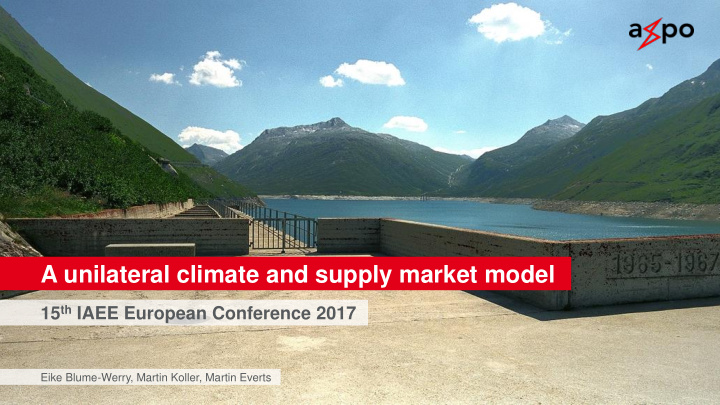



A unilateral climate and supply market model 15 th IAEE European Conference 2017 Eike Blume-Werry, Martin Koller, Martin Everts Page 1
Agenda • Development of EU ETS allowance prices Problematique Hintergrund • Problems of low allowance prices • Legal constrains of unilateral carbon taxation models Legal background Hintergrund • General Agreement on Tax and Tariffs • The British Carbon Price Floor The British model Hintergrund • Limitations of the British model Climate and Supply • Requirements for unilateral carbon taxation models Hintergrund • Market Model The Climate and Supply Market Model 05.09.2017 | 15th IAEE European Conference Page 2
EU ETS allowance prices are widely regarded as too low Due to the low allowance prices EU ETS allowance prices 30 The role of the EU ETS as the main driver for 25 decarbonisation is questioned Negative externalities are no longer properly 20 internalised EUR/tCO 2 Incentives for investments in low carbon 15 generation technologies are missing Reforming the EU ETS has proven a difficult matter 10 5 0 2008 2009 2010 2011 2012 2013 2014 2015 2016 05.09.2017 | 15th IAEE European Conference Page 3 Source: EEX, ICE
Price floors and national CO 2 prices are discussed in the media 05.09.2017 | 15th IAEE European Conference Page 4
Carbon taxation models have to operate within a tight legal framework Electric power is classified as a ‘good’ under international law Art. III:2 GATT General Agreement on Tax and Tariffs (GATT) non- “The products of the territory discrimination rules require equal treatment of ‘like’ products of any contracting party imported/exported from/to WTO members (Most-favoured- imported into the territory of Nation [MFN] treatment) any other contracting party shall not be subject, directly Exceptions are mentioned in Art. XX GATT or indirectly, to internal taxes EU state aid rules set down in the Treaty on the Functioning or other internal charges of any kind in excess of those of the European Union (TFEU) have to be respected applied, directly or indirectly, Compatibility with EU ETS has to be assured to like domestic products.” 05.09.2017 | 15th IAEE European Conference Page 5 Source: WTO
The British Model only works in special circumstances Serves as a top-up of the EU ETS Carbon Price Floor (in real 2009 prices) Introduced to correct market distortion created by low EU ETS prices Contributes to a decline of coal generation Affects only producers in Great Britain; imports are not charged Creates limited competitive disadvantages for domestic electricity producers Cannot be applied elsewhere; island solution 05.09.2017 | 15th IAEE European Conference Page 6 Source: HM Treasury, 2011
Requirements for a unilateral CO 2 taxation model Set incentives for investments low carbon generation technologies Maintain or strengthen a high level of security of supply Come at an acceptable level of costs Affordability Price carbon appropriately and internalise the external costs of CO 2 emissions Comply with international & EU laws and regulation Avoid market distortions on the energy only market Security of Supply Sustainability Prevent competitive disadvantages for domestic producers and consumers Keep complexity and bureaucratic efforts to a minimum 05.09.2017 | 15th IAEE European Conference Page 7
The Climate and Supply Market Model uses Guarantees of Origin Introduces a CO 2 levy on all electricity consumption Offers exemptions for consumption of CO 2 - neutral electricity using Guarantees of Origin (GoO) Restricts exemptions to national GoO Requires generator to report their CO 2 -neutral production and receive corresponding GoO Obliges electricity suppliers to either pay the CO 2 levy or present GoO for every MWh delivered Leads to a subsequent increase of value of GoO 05.09.2017 | 15th IAEE European Conference Page 8
EU ETS allowance prices are incorporated in the model Government sets a CO 2 levy Calculation Formula Average EEA + CH CO 2 intensity is used in the formula for legal reasons 𝐹𝑉𝑆 𝐹𝑉𝑆 (𝐷𝑃 2 𝑚𝑓𝑤𝑧 𝑢𝐷𝑃 2 − 𝐹𝑉 𝐹𝑈𝑇 𝑞𝑠𝑗𝑑𝑓 𝑢𝐷𝑃 2 ) Model is set to become redundant by design 𝑢𝐷𝑃 2 𝐹𝑉𝑆 ∗ 𝐷𝑃 2 𝑗𝑜𝑢𝑓𝑜𝑡𝑗𝑢𝑧 = 𝐷𝑃 2 𝑚𝑓𝑤𝑧 CO 2 levy decreases if EU ETS increases or 𝑁𝑋ℎ 𝑁𝑋ℎ average CO 2 intensity decreases GoO have no additional value in periods 𝐹𝑉𝑆 𝐹𝑉𝑆 where domestic CO 2 -neutral production (50 𝑢𝐷𝑃 2 − 5.3 𝑢𝐷𝑃 2 ) exceeds consumption 𝑢𝐷𝑃 2 𝐹𝑉𝑆 GoO remain valid for a specific time period ∗ 0.23 = 10.3 𝑁𝑋ℎ 𝑁𝑋ℎ (e.g. 1 month) 05.09.2017 | 15th IAEE European Conference Page 9
The Climate and Supply Market Model prices carbon effectively Requires only limited bureaucratic and administrative efforts Differentiates clearly between trading of GoO and the energy-only market Does not interfere in the energy-only market, EU ETS and balance of trade Complies with relevant international and EU laws € either GoO Sets incentives for investments carbon-neutral or generation technologies CO 2 levy Strengthens security of supply CO 2 -neutral power Entails higher costs for consumers 05.09.2017 | 15th IAEE European Conference Page 10
Conclusion EU ETS prices are considered too low to fulfil the intended functions WTO law prevents simple unilateral carbon taxes The British Carbon Price Floor is not an adequate model for others GoO can be used to implement a CO 2 levy The Climate and Supply Market Model offers an effective and legal way of carbon pricing 05.09.2017 | 15th IAEE European Conference Page 11
Many thanks for your attention 15th IAEE European Conference Eike Blume-Werry, eike.blumewerry@axpo.com Page 12
Recommend
More recommend